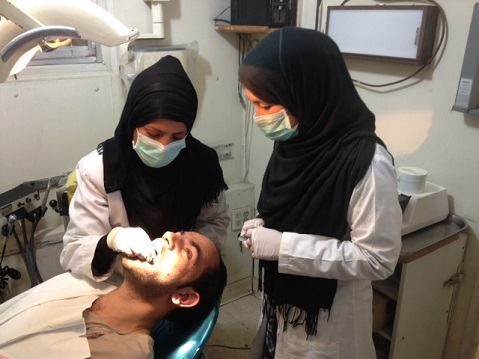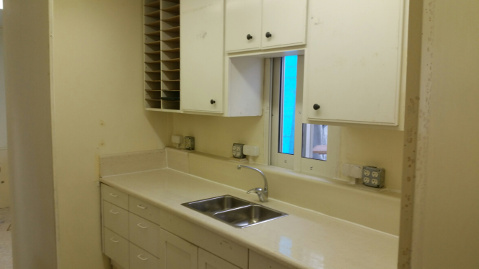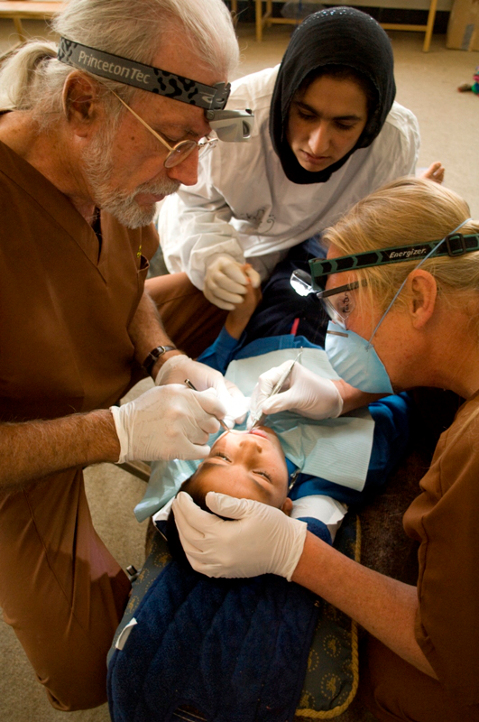Caring in a War-Torn Country
Afghanistan Dental Relief Project Builds New Clinic

The early morning air is crisp, the harbinger of a cold winter. The vibration produced by a Hercules military helicopter 200 feet overhead shakes the ground, deafening anyone trying to talk or even think. It looks like the American Embassy is again ferrying its staff directly to the airport, avoiding the heavily trafficked Great Massoud Road, named for the late martyred hero of the Northern Alliance battle against the Taliban. Our clinic and school sits just 50 meters from this congested motorway, filled with yellow Toyota Corolla taxis, horse-drawn carts, and smoke-belching trucks. Our project manager hands me a piece of twisted metal that landed on the clinic’s roof from a car that exploded next door. Our laboratory technician showed me where part of the car bomber had landed as well.
I am in Afghanistan again, building a new clinic from discarded shipping containers. I’ll be installing the electrical and plumbing systems, cabinetry, and equipment in a new dental clinic that will, hopefully, provide self-funding for the project. This is vitally important for me, since typically I pay from $5,000-$10,000 a month to employ the Afghan clinic staff to operate the free clinic for poor Afghans, as well as the teachers for the dental technician school. My shipment of 50,000 pounds of equipment and supplies has arrived from Santa Barbara, and my 14 helpers and I unload it all, sorting it into huge piles next to the 45-foot Mother Ship that brought it there.
For the next three weeks, I am not a dentist but a construction supervisor. The clinic is closed, so all 14 of the Afghan dentists, assistants, hygienists, lab technicians, cook, housekeeper, mechanic, and guards are helping me. Problem is, only one, the mechanic, has any construction experience, and only two speak English. I have trained them all to practice dentistry like Western dentists, but I certainly did not train them to do construction. My little notebook rapidly fills with how-to drawings.

Eventually, the five plumbing systems and both the Afghan and American electrical systems are complete, and I begin installing the cabinetry. Thankfully, the Goleta Habitat for Humanity store has provided me with a multitude of cabinets, cupboards, and counters, all of which have traveled halfway around the world in a four-month journey to Karachi by ship and then by truck over the Khyber Pass to Kabul and our project site. Particularly valuable are three vanity bathroom cabinets with sinks, one of which goes into each dental operating room. Other cabinets and cupboards fill the sterilizing room, dental laboratory, business office, and waiting area. A diesel-burning stove is happily warming the new waiting room, a gift from Mary Fiske, a Santa Barbara resident and patient in my practice.
I am having a wonderful time working with two of the Afghan women technicians, teaching them how to operate hand and power tools. They are so amazed that they can do this kind of work. I particularly enjoyed showing them how to use a Skilsaw. By the time I left, they could do most things by themselves.
The used Honda generator that I had sent there in 2006 had been donated by a marijuana grower in Northern California, who found that it produced so much heat when operated indoors that the thermal imaging equipment in the federal CAMP helicopters could easily spot it. Only 7500 watts, it could barely power the old clinic. I found an almost-new 50,000-watt generator that another now-defunct NGO had been forced to sell shortly after it was purchased. What a beauty, and only $4,500. But then I learned that the special transformer purchased to convert Afghan electricity to American electricity could not be used with a second electrical supply, so I was really stumped on what to do; we had to have both types of electricity in the new clinic, but the nearest quality center-tap transformers were in Turkey.
Fortunately, we found a transformer manufacturer in Kabul who was able to make one for us in just five days. When he delivered the transformer, I learned that, as a child, he had been playing in an open area when an abandoned Soviet anti-personnel mine had exploded, blowing off one of his legs. He showed me proudly his replacement leg and seemed like a very happy person. In general, I found most Afghans to be very happy and extremely hard working.
Living conditions at the dental project site were very marginal. I slept inside a shipping container at night in below-freezing temperatures. Food mostly consisted of beans and rice, with few amenities. By the end of my stay, I found it very difficult to keep warm, working far into the night and too tired to fix a meal before retiring to my private ice box. After returning home, 10 days passed before I felt normal again. Now I am back in gear, operating my dental practice downtown and coaching the staff in Kabul on the final steps toward opening the new clinic. I am looking forward to seeing the new clinic in operation, providing its own funding, and moving ahead to help in rebuilding the missing technical infrastructure for the dental profession in that troubled country.

Having worked in Afghanistan for 13 years now, I have seen and learned a lot about that country. Each dentist is responsible for over 250,000 people. Ninety percent of the people have no dental services in their area; they must go to the local barber, who will extract their teeth without anesthetic. Few can tolerate this barbarism and just suffer with their abscesses, eventually dying from bacterial septicemia. Going there initially in 2003, I found a totally dysfunctional nation with over 3 million orphans, but what a resource this was for my training program for dental technicians.
The Kabul School of Dental Technology has been operating since 2007, teaching dental assistants, hygienists, and laboratory technicians. In 2005 and 2006, I built a modern dental clinic in a 40-foot shipping container and sent it to Kabul, hiring a dentist and a nurse, training them to work with modern equipment, and eventually hiring two more dentists and training many technicians in the school. Since its inception, the clinic has provided free treatment for over 200,000 Afghans. In 2013, The Santa Barbara Independent named me a Local Hero award, and I have received many other honors for this work.
The new clinic will provide dental services that are more complex than in the old one: Free crowns, root canal treatments, dentures, bridges, implants, and periodontal treatment will be offered. The fees from these treatments will be used to pay for services for the poor. I believe that this self-funded project is a first for Afghanistan. I am confident that it will go on to create new options for Afghans to access quality dental care.
Anyone wishing to comment can contact the Afghanistan Dental Relief Project or email adrp@verizon.net.
James G. Rolfe, DDS, is president and founder of the Afghanistan Dental Relief Project.



